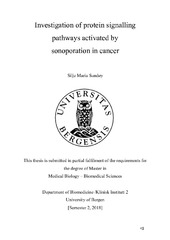| dc.description.abstract | Pancreatic ductal adenocarcinoma (PDAC) is one of the most lethal cancers worldwide. patients with a metastatic PDAC only survive 3 – 5 months if left untreated and less than 25% of diagnosed patients are eligible for surgery. Radiation and chemo–therapy, improves survival by only a few months to live. Overall, the one–year survival is 20%, while the five– year survival rate is a mere 5 – 7%. The poor prognosis of PDAC is predominantly due to the asymptomatic nature of the tumour in early stages. The PDAC tumour is known be severely hypoxic and desmoplastic making it particularly hard to treat. In spite of limited success in increased survival with the chemotherapy, the outcome is still not satisfactory. Clearly, there is a dire need for better and more efficient treatment options. Ultrasound (US) mediated cancer therapy with microbubbles, or sonoporation, is currently one of the emerging cancer treatments. The primary aim of this project is to elucidate the pathways activated by sonoporation in pancreatic cell lines by analysing post–translational modifications (i.e., phosphorylation). The long–term goal is to identify biomarkers for sonoporation that can be used to optimise sonoporation therapy. The pathways investigated were the Mitogen Activated Kinases (MAPKs) ERK 1/2, p38 and SAPK/JNK; the unfolded protein response (UPR) protein eIF2a; and the JAK/STAT pathway protein STAT3. Furthermore, ribosomal protein S6 of the PI3KmTOR pathway was investigated, in addition to MLC and MYPT1, which are regulators in the Rho/ROCK pathway. More specific aims were to: - Iinvestigate of protein signalling pathways activated by sonoporation in the AML cell line MOLM–13 - develop methodology for in vitro optimisation of sonoporation - investigate the influence of sonoporation on cell viability - investigate protein signalling pathways activated by sonoporation in the pancreatic cell lines MIA PaCa–2, PANC-1 and BxPC-3 Cells were treated using bespoke US treatment chambers designed for suspension or adherent cells. Adherent cells were treated in the bioreactor Petaka G3 LOT. Following sonoporation, cell viability was assessed using trypan blue (live/dead cell exclusion assay), Hoechst 33342 (apoptotic assay) and WST-1 (metabolic assay). Furthermore, phosphorylation status of selected signalling proteins in sonoporated cells were analysed by western blot. For pancreatic cell lines methodology was optimised, including viability assays, growth rate in Petakas, cell detachment, incubation time post sonoporation before protein extraction and, finally, western blotting was optimised by inducing phosphorylation to test the antibodies in aforementioned cell lines. Sonoporation–induced cell signalling was successfully detected using MOLM-13. Results showed that enzymatic cell detachment with pre-heated trypsin can influence cell signalling. Sonoporation of MIA PaCa-2 cells showed that the cells’ viability was affected at the higher US intensities without microbubbles, shown as decreased metabolic activity (WST–1), suggesting that US alone affects cell viability. Trypan blue showed a relative increase of trypan blue stained cells at low US intensity. Hoechst 33342 analysis showed a trend of decreasing number of dead cells with and without microbubbles with increasing US intensity, indicating that high US and microbubbles affects cell viability. In western blot analysis of the MAPKs, no phosphorylation of p38 or JNK was detected, however, there was an increasing phosphorylation of ERK 1/2. eIF2a, and STAT3 were phosphorylated in all samples, suggesting they are constitutively active in MIA PaCa-2. S6 was phosphorylated at the higher US intensities with microbubbles. MLC, was phosphorylated at the highest US intensity with microbubbles, while MYPT1 was not phosphorylated. Methodology for in vitro optimisation of sonoporation was developed. Using this methodology, we have identified several pathways activated by sonoporation that may have potential as biomarkers for PDAC that can be used to optimise sonoporation therapy. It was also found that higher US intensities and microbubbles may have an effect of cell viability, depending on the US intensity. However, these are preliminary results which needs to be confirmed. | en_US |
